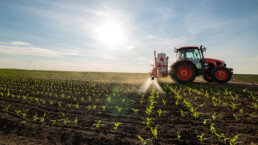In line with the objectives of the European Union's Global Gateway strategy and Angola's economic diversification agenda, the 2nd Angola-European Union Business Forum will focus on the strategic value chains of agribusiness and fisheries and the sectors of digitalization, transport and logistics, green energy and critical raw materials. Use the buttons below for more information on the context and challenges of each sector.

Agri-food value chains
Angola has the greatest agricultural potential in southern Africa, considering the country's water resources, favorable climate and available arable land. This potential is, however, largely untapped, with only 5.9 million hectares of the 35 million hectares of available arable land cultivated between 2020-2021. National agricultural production is lower than demand, and Angola imports more than half of its food needs.
Challenges
Doubling the cultivated area. Angola currently uses only around 10% of its total land with agricultural potential and aims to more than double the cultivated area by 2050, converging towards a use of total agricultural land on average with that observed in the other SADC and sub-Saharan African countries.
Increase agriculture's contribution to national GDP. The agricultural sector contributes around 8.6% of GDP, and is expected to grow by 2.3 pp to 10.9% in 2030.
Increasing the sector's productivity. The low productivity of each hectare planted is another challenge to overcome, with lower productivity in Angola compared to other comparable countries in all crops, with just a few exceptions: cassava, bananas and citrus fruits. In order to reverse this reality, it is essential to increase access to and improve the application of the main agricultural inputs: water (through irrigation), fertilizers and pesticides, the use of which is below that of regional and world peers. In particular, it will be essential to develop national capacity and achieve self-sufficiency in inputs with a major direct impact on productivity, namely fertilizers (mixing and production), pesticides, and seeds, reducing dependence on foreign sources and ensuring suitability for climatic and soil conditions.
Transition from subsistence to commercial agriculture. It is not possible, nor would it be desirable, to transform the sector without the participation of family farmers, not only because of the sector's weight in employment, but above all because they are the ones who cultivate more than 90% of the land and ensure more than 80% of our national production. The solutions put forward are therefore based on creating conditions that help family farmers increase their productivity and aim to transition them from subsistence farming to commercial farming.
Growth of the business subsector. The entrepreneurial sub-sector is also set to grow and play a major role, especially in intensive crops which require larger tracts of land, greater investment and more complex techniques.
Provision of financial products and services. The growth of the sector also requires the intervention of other private agents who should support family and business producers, particularly in the provision of financial products and services, such as agricultural credit and insurance, which should help to reduce risk and thus make the sector more appealing to investors.

Fisheries and associated sectors
Overfishing and the foreseeable decline in species diversity require a transition from capture fisheries to aquaculture. Approximately 90% of marine species in Angola are already at the limit of exploitation today and by 2050. On a global scale, fish stocks are expected to be on the verge of collapse. The development of the aquaculture industry is therefore fundamental to ensuring the sustainability of the sector and the supply of these food products to the population.
Challenges
The country's potential. Almost 99% of Angola's surface water available for continental aquaculture is currently unexploited. In fact, Angola ranks second among all Southern African Development Community (SADC) countries in terms of available freshwater surface area. Other competitive advantages for the development of continental aquaculture include low levels of pollution, a favorable temperature range of between 20°C and 30°C, and the good topography of the soil, made up of plateaus. With regard to demand, forecasts point to a growing imbalance between supply and demand in neighboring countries, which suggests the opportunity to increase production to meet demand in the SADC region. At the same time, crustaceans are in great demand in America and Asia, creating opportunities for intercontinental export, and there are species especially suitable for continental aquaculture in our country.
Attracting investors to develop continental and marine aquaculture and to develop production processing, including domestic production of the necessary inputs (fry and feed). This will be possible by promoting investment in aquaculture production, particularly with the dissemination of land and marine conditions in the country, and by encouraging the development of the necessary infrastructure for the sector.
Ensure regulation and control of the industry, encouraging the certification of fish by independent bodies to facilitate greater demand for and export of Angolan fish. In addition, we will supervise industrial fishing and formalize artisanal (non-industrial, small-scale) fishing, redirecting artisanal fishing workers to aquaculture whenever appropriate.
Developing infrastructures by coordinating actions with other sectors, and improving the management of public infrastructures through concessions, for example by assigning the operation of cold stores and artisanal fishing support centers to private companies that have the capacity to increase the competitiveness and efficiency of these infrastructures.


Green energy
Historically, the energy sector in Angola has consisted of two main sources: thermoelectric and hydroelectric. In the coming decades, it will be essential to expand the use of hydroelectric power and invest in the development of solar energy. Renewable energies and solar energy in particular will become important in the future, driven by the growing demand for energy, the lower cost per unit of these renewable sources and the country's energy potential. In addition, the increased use of renewable resources will make it possible to export other resources, such as natural gas.
Challenges
Development of the energy network. It is estimated that electricity demand will increase more than fivefold by 2050. Such a sharp rise will be driven by an increase in population growth, the electrification rate and the rate of per capita consumption. It is therefore imperative that Angola properly develops its energy network and ensures the necessary level of investment in the sector.
Improving renewable production capacity. Angola's energy matrix has grown mainly through hydroelectric plants, but the country still has little renewable production capacity.
Investing to boost the energy transition. A priority in the energy sector will be to launch a program to attract private sector investment to add renewable generation capacity and the transmission network, creating the necessary conditions (e.g. PPP guarantee fund, risk mitigation measures) to boost the PPP model in the sector and/or attract multilateral capital (e.g. World Bank), especially for renewable energy generation.
Need for regional integration in the energy market. Growing demand and dependence on natural conditions for renewable energy sources require Angola to prioritize regional integration into the Southern African Power Pool (SAPP). This will allow Angola to mitigate the risk of an energy deficit in the national system due, for example, to drought situations, and to dispose of potential extra capacity in the national system. By 2027 Angola will develop a plan to expand the supply of electricity from renewable sources to the SADC and COMESA regional markets.

Digital innovation
The telecommunications and information technology sector is critical in accelerating economic development, representing an indirect impact of around twice its direct impact on the economy. Taking full advantage of this sector's potential to transform the lives and livelihoods of the Angolan people requires a substantial improvement in access, which requires a substantial increase in the penetration and territorial dispersion of mobile telephony and the internet, particularly in rural areas.
Challenges
Lack of regulation to stimulate competitiveness and innovation in the telecommunications and ICT sector. The recent entry of an international operator, Africell, into the telecommunications market demonstrates Angola's commitment to increasing competitiveness in the sector and levels of investment and expansion of access to telecommunications and information technologies. However, in order to develop digital ecosystems that are characteristic of modern economies, increasing the competitiveness and infrastructural capacity of the telecommunications market will also have to serve as a catalyst for the development of information technologies, and so it will be necessary to create a legal and competitive environment that encourages the rapid development and adoption of these technologies, and so the country will have to take a more open and flexible position in relation to digital innovation, at the forefront of developing new laws and adoption mechanisms linked to the information technology ecosystem.
Better regulation and more investment in technology, differentiated by territory. Angola has well-developed technological bases in terms of infrastructure and greater and better access to technological literacy. However, these resources need incentives that are differentiated according to Angola's diverse territory: more connectivity, less bureaucracy, more tax incentives, better regulation. The concentration of investment and development in Luanda is another challenge.
The need for a digital ecosystem that is a catalyst for development. A digital ecosystem that acts as a transmission belt for increased productivity in all sectors of the Angolan economy. Digital ecosystems are an integral part of the global economy. The full development of Angola's digital ecosystem is essential for increasing connectivity and digital inclusion, as well as being responsible for providing the technological tools needed to achieve our goals. For example, in education and health, digital tools play an essential role in effectively tackling the challenges we face today. In agriculture, we plan to use electronic voucher systems, which have proved to be a highly dynamic instrument for development. This type of intervention, which cuts across all sectors, only works within the framework of a dynamic telecommunications and information technology ecosystem. Achieving these changes requires training our human resources and creating incentives that attract private investment to the sector.
